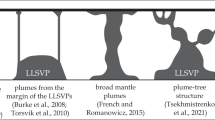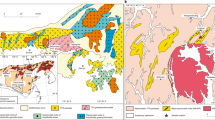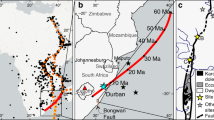Abstract
Widespread flood basalt volcanism and continental rifting in the northeast Atlantic in the early Tertiary period (∼55 Myr ago) have been linked to the mantle plume now residing beneath Iceland1,2,3,4,5. Although much is known about the present-day Iceland plume6,7,8,9, its thermal structure, composition and position in the early Tertiary period remain unresolved. Estimates of its temperature, for example, range from >1,600 °C in some plume models3 to ∼1,500 °C based on the volume and composition of basaltic crust10,11,12. Several recent studies4 have emphasized similarities in the thermal and chemical structure of the Tertiary and present-day plumes to argue for stability of the mantle anomaly, whereas others12,13 relate variations in basalt volumes and compositions to changes in plume flux. Moreover, some authors1,2,13 have assumed that the plume was rift-centred for its entire history, whereas others argue that it became ridge-centred only after plate separation14,15. Here we report compositional data for ∼6,000 metres of flood basalts erupted in east Greenland, close to the inferred plume axis, that we use to constrain the Tertiary plume structure. Rare-earth-element systematics place limits on the pressures and extents of mantle melting and show that the mantle was initially moderately hot (∼1,500 °C), but that its temperature declined during flood volcanism. These observations are difficult to reconcile with current plume-head models, and call for important lithospheric control5,10,16,17,18 on actively upwelling mantle along the rifted margin.
This is a preview of subscription content, access via your institution
Access options
Subscribe to this journal
Receive 51 print issues and online access
$199.00 per year
only $3.90 per issue
Buy this article
- Purchase on Springer Link
- Instant access to full article PDF
Prices may be subject to local taxes which are calculated during checkout



Similar content being viewed by others
References
Brooks, C. K. Rifting and doming in southern East Greenland. Nature 244, 23–25 (1973).
White, R. S. & McKenzie, D. P. Magmatism at rift zones: The generation of volcanic continental margins and flood basalts. J. Geophys. Res. 94, 7685–7729 (1989).
Campbell, I. H. & Griffiths, R. W. Implications of mantle plume structure for the evolution of flood basalts. Earth Planet. Sci. Lett. 99, 79–93 (1990).
Fitton, J. G., Saunders, A. D., Norry, M. J., Hardason, B. S. & Taylor, R. N. Thermal and chemical structure of the Iceland plume. Earth Planet. Sci. Lett. 153, 197–208 (1997).
Larsen, H. C. & Saunders, A. D. Tectonism and volcanism at the SE Greenland rifted margin: a record of plume impact and later continental rupture. Proc. ODP Sci. Res. 152, 502–533 (1998).
Schilling, J.-G., Meyer, P. S. & Kingsley, R. H. Evolution of the Iceland hotspot. Nature 296, 313–320 (1982).
Elliott, T. R., Hawkesworth, C. J. & Gronvold, K. Dynamic melting of the Iceland plume. Nature 351, 201–206 (1991).
Hémond, C., Arndt, N., Lichtenstein, U., Hofmann, A. W., Oskarsson, N. & Steinthorson, S. The heterogeneous Iceland plume: Nd-Sr-O isotopes and trace element constraints. J. Geophys. Res. 98, 15833–15850 (1993).
Wolfe, C. J., Bjarnason, I. T., VanDecar, J. C. & Solomon, S. C. Seismic structure of the Iceland mantle plume. Nature 385, 245–247 (1997).
Fram, M. S. & Lesher, C. E. Geochemical constraints on mantle melting during creation of the North Atlantic basin. Nature 363, 712–715 (1993).
White, R. S. & McKenzie, D. P. Mantle plumes and flood basalts. J. Geophys. Res. 100, 17543–17585 (1995).
Barton, A. J. & White, R. S. Crustal structure of Edoras Bank continental margin and mantle thermal anomalies beneath the North Atlantic. J. Geophys. Res. 102, 3109–3129 (1997).
Schilling, J.-G. & Noe-Nygaard, A. Faeroe-Iceland plume: rare-earth evidence. Earth Planet. Sci. Lett. 24, 12–14 (1974).
Lawver, L. A. & Müller, R. D. Iceland hotspot track. Geology 22, 311–314 (1994).
Tegner, C. et al . 40Ar−39Ar geochronology of Tertiary mafic intrusions along the East Greenland rifted margin: Relation to flood basalts and the Iceland hostpot track. Earth Planet. Sci. Lett. 156, 75–88 (1998).
Mutter, J. C., Buck, W. R. & Zehnder, C. M. Convective partial melting 1. A model for the formation of thick basaltic sequences during the initiation of spreading. J. Geophys. Res. 93, 1031–1048 (1988).
Anderson, D. L., Zhang, Y. S. & Tanimoto, T. in Magmatism and the Causes of Continental Break-up (eds Storey, B. C., Alabaster, T. & Pankhurst, R. J.) 99–124 (Spec. Publ. 68, Geol. Soc. London, 1992).
Sleep, N. H. Lateral flow of hot plume material ponded at sublithospheric depths. J. Geophys. Res. 101, 28065–28083 (1996).
Larsen, L. M., Watt, W. S. & Watt, M. Geology and petrology of the Lower Tertiary plateau basalts of the Scoresby Sund region, East Greenland. Bull. Grønlands Geol. Unders. 157, 1–164 (1989).
Pedersen, A. K., Watt, M., Watt, W. S. & Larsen, L. M. Structure and stratigraphy of the early Tertiary basalts of the Blosseville Kyst, East Greenland. J. Geol. Soc. Lond. 154, 565–570 (1997).
Sun, S. S. & McDonough, W. F. in Magmatism in the Ocean Basins (eds Saunders, A. D. & Norry, M. J.) 313–345 (Spec. Publ. 42, Geol. Soc., London, 1989).
Schilling, J.-G. et al . Petrologic and geochemical variations along the Mid-Atlantic ridge from 29° N to 73° N. Am. J. Sci. 283, 510–586 (1983).
Klein, E. M. & Langmuir, C. H. Global correlations of ocean ridge basalt geochemistry with axial depth and crustal thickness. J. Geophys. Res. 92, 8089–8115 (1987).
Fram, M. S. & Lesher, C. E. Generation and polybaric differentiation of magmas of East Greenland Early Tertiary flood basalts. J. Petrol. 38, 231–275 (1997).
McKenzie, D. & Bickle, M. J. The volume and the composition of melt generated by extension of the lithosphere. J. Petrol. 29, 625–679 (1988).
Langmuir, C. H., Klein, E. M. & Plank, T. in Mantle Flow and Melt Generation at Mid-ocean Ridges (eds Morgan, J. P., Blakmun, D. K. & Sinton, J. M.) 183–280 (Am. Geophys. Union Monogr., Washington DC, 1992).
Schilling, J.-G. Fluxes and excess temperatures of mantle plumes inferred from their interactions with migrating mid-ocean ridges. Nature 352, 397–403 (1991).
Fram, M. S., Lesher, C. E. & Volpe, A. M. Mantle melting systematics: the transition from continental to oceanic volcanism on the Southeast Greenland margin. Proc. ODP Sci. Res. 152, 373–386 (1998).
Hardason, B. S., Fitton, J. G., Ellam, R. M. & Pringle, M. S. Rift relocation — a geochemical and geochronological investigation of a paleo-rift in northwest Iceland. Earth Planet. Sci. Lett. 153, 181–196 (1997).
Hopper, J. R. et al . Magmatism and rift margin evolution: Evidence from northwest Australia. Geology 20, 853–857 (1992).
Holbrook, W. S. & Kelemen, P. B. Large igneous province on the US Atlantic margin and implications for magmatism during continental breakup. Nature 364, 433–436 (1993).
Hofmann, A. W. Mantle geochemistry: the message from oceanic volcanism. Nature 385, 219–229 (1997).
Lesher, C. E. & Baker, M. B. Near-solidus phase relations of mantle peridotite at 3.6-5 GPa. Eos 78, 812 (1997).
Acknowledgements
We thank our colleagues (S. Bernstein, D. K. Bird, C. K. Brooks, R. A. Duncan, J.Helgason, P. B. Kelemen, P. S. Neuhoff, P. O'Day and M. Storey) involved in sampling of East Greenland flood basalts in 1995, coordinated by A. K. Pedersen and T. F. D. Nielsen. Discussions with H. C. Larsen, T.F. D. Nielsen, C. K. Brooks, M. Storey, and J. R. Hopper helped to mature the ideas presented here. The Danish National Research Foundation and the US NSF supported this work.
Author information
Authors and Affiliations
Corresponding author
Supplementary Information
Rights and permissions
About this article
Cite this article
Tegner, C., Lesher, C., Larsen, L. et al. Evidence from the rare-earth-element record of mantle melting for cooling of the Tertiary Iceland plume. Nature 395, 591–594 (1998). https://doi.org/10.1038/26956
Received:
Accepted:
Issue Date:
DOI: https://doi.org/10.1038/26956
This article is cited by
-
Sulphide melt and aqueous fluid saturation in the PGE–Au mineralisation of the Skaergaard intrusion: evidence from melt inclusions
Contributions to Mineralogy and Petrology (2020)
-
Transient mantle cooling linked to regional volcanic shut-down and early rifting in the North Atlantic Igneous Province
Bulletin of Volcanology (2020)
-
Geochemical and Sr–Nd isotope variations within Cretaceous continental flood-basalt suites of the Canadian High Arctic, with a focus on the Hassel Formation basalts of northeast Ellesmere Island
International Journal of Earth Sciences (2015)
-
Parental magma of the Skaergaard intrusion: constraints from melt inclusions in primitive troctolite blocks and FG-1 dykes
Contributions to Mineralogy and Petrology (2010)
-
Iron in plagioclase in the Bushveld and Skaergaard intrusions: implications for iron contents in evolving basic magmas
Contributions to Mineralogy and Petrology (2010)
Comments
By submitting a comment you agree to abide by our Terms and Community Guidelines. If you find something abusive or that does not comply with our terms or guidelines please flag it as inappropriate.



